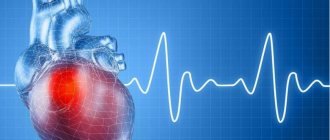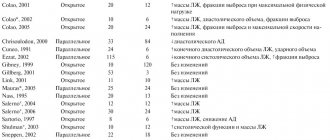Magnesium preparations in cardiological practice
Despite the achievements of modern medicine, cardiovascular diseases (CVD) in the Russian Federation, as well as throughout the world, remain one of the most common diseases that practitioners have to deal with. First of all, this is, of course, arterial hypertension (AH), coronary heart disease (CHD) and chronic heart failure (CHF). These diseases are the main cause of death in both developed and developing countries [1]. This makes the problem of optimizing pharmacotherapy in order to reduce cardiovascular risk extremely important, and the search for an individual approach to the management of patients with various CVDs and a differentiated choice of drugs remains an urgent problem for the practicing physician. Today, a doctor has a wide selection of effective pharmacological agents for the treatment of various CVDs, which should be prescribed following the relevant Russian and international recommendations based on a large evidence base.
In recent years, the use of drugs that affect the balance of micro- and macroelements (sodium, potassium, calcium, magnesium, chlorine, phosphorus, sulfur, etc.), which are necessary for the normal functioning and performance of the body and which the human body is not able to synthesize on its own, has become promising. . Maintaining a normal level of these elements is only possible if an adequate amount of them is supplied with food. An optimally balanced diet helps maintain normal levels of macro- and microelements. But these are only ideal conditions, rarely achievable in modern life.
One of the most common types of mineral deficiency in many countries is magnesium deficiency, which occupies one of the leading places in human pathologies caused by disorders of mineral metabolism (manganese, iodine, zinc, copper, calcium), and, according to the International Classification of Diseases, 10th revision , is registered as a separate disease - E 61.2 [2, 3].
Data from a number of observations indicate that from 25% to 40% of the adult population are deficient in this important macronutrient.
Given the prevalence of magnesium deficiency, it is expected that a large number of patients with cardiovascular disease will have magnesium deficiency of varying severity.
Mechanism of action of magnesium
One of the macroelements important for the body is magnesium. From the point of view of biological function, magnesium is a cofactor and activator of a number of enzymes - enolase, alkaline phosphatase, carboxylase, hexokinase. Another role of magnesium ions is stabilizing. Magnesium ions stabilize the substrate molecules - they neutralize the negative charge of the substrate, the active center of the enzyme, help maintain the tertiary and quaternary structures of the enzyme protein molecule, facilitate the attachment of the substrate to the enzyme and thereby facilitate the chemical reaction, the magnesium-ATP complex, stabilizing the ATP molecule, facilitating its attachment and “correct” orientation in the active site of the enzyme, weakening the phosphoester bond and facilitating the transfer of phosphate to glucose. In some cases, magnesium ion can help attach the coenzyme, promoting the activation of metalloenzymes.
Magnesium contributes to the stability of the cell structure during growth and takes part in the process of regeneration of body cells.
Data have been obtained confirming the irreplaceable role of magnesium in the absorption of vitamins B1 (thiamine), B6 (pyridoxine) and vitamin C [4, 5].
The participation of magnesium in phosphorus and carbohydrate metabolism, in protein synthesis, and in the transmission of neuromuscular impulses has been established [4].
Magnesium is involved in maintaining the electrical potential of membranes, promotes the penetration of calcium, sodium, and potassium ions through them, and takes part in the transmission of nerve impulses. It regulates the passage of the inhibition signal from the central parts of the nervous system to the peripheral nervous system. With a lack of magnesium, the nervous system remains in a state of overexcitation and, as a result, chronic stress is observed. Magnesium, in turn, is called an anti-stress element.
Magnesium can affect calcium levels by influencing hormones that control calcium absorption and metabolism. In the regulation of vascular tone, magnesium and calcium ions act as antagonists: calcium plays a leading role in the contraction of smooth muscles of blood vessels, magnesium, on the contrary, in their expansion, promotes the elimination of excess cholesterol, the absorption of calcium and phosphorus.
Magnesium is able to increase insulin secretion and improve its penetration into cells. It is also necessary for the production of brain neuropeptides, stimulates intestinal motility, promotes the secretion of bile, and is involved in the production of catecholamines.
Lack of magnesium in the body
Since magnesium ranks 4th in content in the body, it is natural that with chronic magnesium deficiency, functional disorders occur in many organs and tissues.
Magnesium deficiency can be caused by changes in its distribution between blood serum and cells, decreased dietary intake, or excessive loss. Unlike primary magnesium deficiency, which is associated with a person’s constitutional characteristics, secondary magnesium deficiency is associated with living conditions or diseases.
Living conditions that cause magnesium deficiency:
- insufficient food intake (nutritional deficiency), intravenous therapeutic nutrition;
- hypocaloric diet, unbalanced diet (excessive levels of lipids, calcium, phosphates);
- stress, strenuous physical work;
- physical inactivity;
- exposure to high temperatures;
- increased consumption of magnesium during pregnancy, intensive growth, recovery, with excessive sweating, with excessive physical exertion, with chronic alcoholism;
- hormonal contraception.
Magnesium deficiency associated with diseases and their therapy:
- impaired absorption of macronutrients in the intestine (disease of the small intestine, reduction in the absorptive surface of the intestine after surgery or during radiotherapy, steatorrhea, dysbiosis in the large intestine); impaired insulin production;
- nephrotic syndrome;
- hypercortisolism;
- hypercatecholaminemia;
- hyperaldosteronism;
- hyperthyroidism;
- arterial hypertension;
- myocardial infarction;
- obesity;
- diuretic, cytostatic therapy;
- long-term use of antibiotics (gentamicin), diuretics, antitumor and other medications;
- poisoning with certain substances (aluminum, lead, cobalt, manganese, cadmium, beryllium, nickel).
Physiological effects of magnesium
Due to the combination of such properties inherent in this element, the physiological effects of magnesium are very diverse and are manifested in the fact that it has a beneficial effect on bone growth; helps slow heart rate, reduces high blood pressure; promotes bronchodilation; used as a prophylactic for muscle and joint pain, chronic fatigue syndrome, migraines, etc.
The effects of magnesium on the cardiovascular system are extremely important:
- hypotensive effect - has a hypotensive effect due to negative chrono- and inotropic effects, decreased vascular tone, inhibition of transmission in the autonomic ganglia, inhibition of the vasomotor center;
- anti-ischemic effect - due to the restoration of endothelium-dependent vasodilation, normalization of lipid spectrum indicators, improvement of rheological properties of blood, reduction of platelet aggregation activity, depressor effect on the inotropic function of the heart [6–8];
- antiarrhythmic effect - magnesium has a membrane-stabilizing effect, a depressor effect on the excitability and conductivity of the cell [9]. Depletion of magnesium stores causes significant adverse effects on the myocardium [10]. Violation of the content of potassium and magnesium ions and their ratio is a significant risk factor for the development of arrhythmias. In the Framingham Study, extrasystoles were detected in 5.5% of study participants (n = 3327, mean age 44 years). At the same time, long-term hypomagnesemia correlates with a high incidence of ventricular extrasystoles, tachycardia, and ventricular fibrillation (p = 0.01). This pattern remained significant even after taking into account adjustments for left ventricular mass, including in volunteers without clinically significant disease [11]. The PROMISE Study revealed a higher incidence of ventricular extrasystole and high mortality in the group of patients with hypomagnesemia compared to groups with normo- and hypermagnesemia [12];
- effect on connective tissue - magnesium affects collagen metabolism, reducing the severity of dysplastic changes in connective tissue [13, 14].
In recent years, among the possible pathogenetic mechanisms for the formation of mitral valve prolapse, some researchers point to a chronic deficiency of magnesium ions, which leads to disruption of the formation of connective tissue structures of the supporting trophic framework of the heart, which causes a chaotic arrangement of collagen fibers, disruption of its synthesis and biodegradation [15].
Magnesium ions are of great importance for the normal functioning of connective tissue. In a number of animal experiments, it was shown that magnesium deficiency leads to an increase in the activity of collagenases, in particular matrix metalloproteinases, while the metabolism of the structural components of the extracellular matrix, primarily collagen, was disrupted. Along with an increase in the activity of metalloproteinases, magnesium deficiency reduces the enzymatic activity of transglutaminases and lysyl oxidases involved in the formation of cross-links, resulting in a decrease in the mechanical strength of collagen fibers [15–17].
Symptoms of magnesium deficiency
Signs of magnesium deficiency are nonspecific. Clinically, magnesium deficiency can manifest itself in the form of endocrine-metabolic, mental and neurological disorders, in the form of disorders of various organs and systems, including the cardiovascular and musculoskeletal system.
The main complaints presented by patients: paresthesia in the form of impaired sensitivity, sensations of numbness, tingling, itching, crawling, etc., muscle cramps, increased neuromuscular excitability, fatigue, sudden dizziness accompanied by loss of balance, irritability, insomnia , nightmares, difficult awakening, deterioration in concentration, loss of appetite, constipation, nausea, diarrhea, vomiting, increased blood pressure, arrhythmias, angina pectoris, vasospasms, atrophic skin manifestations in the form of hair loss, increased brittleness of nails.
Examinations may reveal signs of dysfunction of the adrenal glands, the development of diabetes mellitus, urolithiasis and cholelithiasis, and immunodeficiency states. Such patients have an increased likelihood of developing tumor diseases.
Since the metabolism of magnesium and calcium is closely related, with magnesium deficiency the calcium level also decreases and osteoporosis develops. This is also facilitated by dysfunction of the parathyroid gland.
The cardiovascular system also responds to magnesium deficiency: patients experience accelerated progression of atherosclerosis, tachycardia, arrhythmias, mitral valve prolapse, and a decrease in the electrical stability of the myocardium, characterized by an increase in the dispersion and/or duration of the QT interval. In such patients, an increase in mortality from coronary artery disease was observed.
There is an opinion that cases of early myocardial infarction among people aged 30–40 years are associated with reduced magnesium content in the heart muscle.
Clinical experience with the use of magnesium preparations in cardiology
It is obvious that magnesium deficiency in diseases of the cardiovascular system cannot be compensated only by changing the diet; the use of magnesium preparations is necessary.
Inorganic magnesium preparations, such as magnesium sulfate, have extremely low bioavailability of magnesium and have a number of pronounced side effects [4, 18].
To compensate for magnesium deficiency, it is necessary to use magnesium preparations characterized by high bioavailability - organic magnesium preparations [19].
One of these drugs is Magnerot - a salt of magnesium and orotic acid. Orotic acid is one of the products of pyrimidine biosynthesis. In the human body, orotic acid is synthesized in the liver from aspartate and carbamoyl phosphate, subject to the physiological state of hepatocytes. Orotic acid salts are used as a mineral carrier, since orotic acid increases targeted transport into skeletal muscle myocytes and cardiomyocytes, and also has a number of additional advantages compared to inorganic salts.
To date, a large evidence base has been accumulated indicating the high effectiveness of magnesium orotate in various conditions accompanied by magnesium deficiency, including in patients undergoing coronary surgery [3, 7, 20–24].
The greatest experience in the use of magnesium orotate is in patients with mitral valve prolapse (MVP) as pathogenetic therapy. A long-term, over 15 years, observation of patients who took the drug at a dose of 1500 mg/day twice a year for 3 months showed that this leads to an improvement in clinical condition and is accompanied by a decrease in heart rate, number of episodes of tachycardia, duration QTc interval, frequency of paroxysmal supraventricular tachycardia, supraventricular and ventricular extrasystole [25]. The use of magnesium orotate in patients with mitral valve prolapse also improves quality of life and echocardiography indicators (reducing the depth of mitral valve prolapse, reducing the degree of mitral regurgitation) [26]. These effects are realized due to the fact that the drug causes changes in the architectonics of loose fibrous connective tissue, manifested in the orderliness of the relative arrangement of fibers, an increase in the content of amorphous substance of loose fibrous connective tissue involved in the metabolic processes of the myocardium, improved diffusion capacity and architectonics of connective tissue, which determines improved elasticity and extensibility [27].
The anti-ischemic effect of magnesium is manifested due to a positive effect on endothelium-dependent vasodilation [6], as well as normalization of metabolism in ischemic tissues, and a depressor effect on the inotropic function of the heart [8]. These same effects also explain the positive dynamics in patients with severe CHF when magnesium is included in complex therapy [7].
The drug is also effective in the prevention of supraventricular tachyarrhythmias during surgical interventions in patients with combined cardiac and urological pathologies. If the drug is prescribed before surgery, the likelihood of arrhythmia decreases by 16% [9].
An important positive aspect of magnesium preparations in cardiological practice is also that they can be used for the correction and prevention of hyperkalemia associated with long-term courses of potassium-sparing diuretics, angiotensin-converting enzyme inhibitors and angiotensin receptor blockers, as well as associated with the presence of metabolic syndrome. With the use of magnesium orotate, the well-being of patients improves and laboratory parameters are normalized [28].
Thus, magnesium deficiency is one of the most common types of mineral deficiency, occurring in 25–40% of the adult population. Literature data and more than 20 years of experience in the clinical use of magnesium preparations indicate their good effectiveness and high safety profile in patients with various cardiac pathologies.
Literature
- Ezzati M., Lopez A., Rodgers A., Vander Hoorn S., Murray CJL eds. Comparative Quantification of Health Risks: Global and Regional Burden of Disease Attributable to Selected Major Risk Factors. Geneva: World Health Organization; 2004.
- Bourre JM Effects of nutrients (in food) on the structure and function of the nervous system: update on dietary requirements for brain. Part 1: micronutrients // J. Nutr. Health Aging. 2006; 10 (5): 377–385.
- Classen HG Magnesium orotate-experimental and clinical evidence // Rom. J. Intern. Med. 2004; 42(3):491–501.
- Gromova O. A. Magnesium and pyridoxine. Basic knowledge. M.: ProtoTip, 2006. 234 p.
- Torshin I. Yu., Gromova O. A., Gusev E. I. Mechanisms of anti-stress and antidepressant action of magnesium and pyridoxine // Journal of Neurology and Psychiatry. 2009, No. 11, p. 107–111.
- Kirichenko A. A., Flegentova O. N., Novichkova Yu. N., Vinogradova I. V., Ryazantsev A. A., Yurchenko K. V. Effect of therapy with Magnerot on cardialgia in postmenopausal women // Attending Physician. 2005. No. 5. P. 76 –77.
- Stepura OB, Martynow AI Magnesium orotat in severe congestive heart failure (MACH) // Int J Cardiol. 2009, May 1; 134(1):145–147.
- Ezhov A.V., Pimenov L.T., Zamostyanov M.V. Clinical effectiveness of Magnerot in the treatment of stable angina pectoris in combination with arterial hypertension in the elderly // Ros. honey. lead. 2001. No. 1. P. 71–74.
- Davydova S., Yarovoy S. Magnesium preparations in the treatment and prevention of supraventricular tachyarrhythmias in urological patients // Doctor. 2011. No. 9. pp. 44–49.
- Chakraborti S., Chakraborti T., Mandal M. et al. Protective role of magnesium in the cardiovascular diseases: A review // Mol Cell Biochem. 2002; 238:163–179.
- Tsuji H., Venditti FJ Jr., Evans JC et al. The associations of levels of serum potassium and magnesium with ventricular premature complexes (the Framingham Heart Study) // Am J Cardiol. 1994; 74:232–235.
- Eichhorn EJ, Tandon PK, Dibianco R. et al. The Study Group Clinical and prognostic significance of serum magnesium concentration in patients with severe chronic congestive heart failure: The Promise Study // J Am Coll Cardiol. 1993; 21(3):634–640.
- Libova L. T., Dobrynina V. A., Kalenik S. A., Brovkina E. G. Use of the drug MAGNEROT® for mitral valve prolapse and stage I hypertension // New Millennium Medicine. 2011. No. 4. P. 3–4.
- Martynov A.I., Akatova E.V., Nikolin O.P. Clinical effectiveness of magnesium orotate in patients with rhythm disturbances and arterial hypertension with mitral valve prolapse // Cardiovasc. therapy and prevention. 2009; 8:8–12.
- Baker P., Bansal G., Boudoulas H. et al. Floppy mitral valve chordae tendineae: histopathologic alterations // Hum Pathology. 1998; 19(5):507–512.
- Kitlinski M., Konduracka E., Piwowarska. Evaluation of magnesium cation levels in serum of patients with mitrale valve prolapse syndrome // Folia Med Cracov. 2000; 41 (3–4): 17–24.
- Disse S., Abergei E., Derrebi A. et al. Mapping of the first locus for autosomal dominant myxomatous mitral valve prolapse to chromosome 16 p11.2–p.12.1 // Am J Hum Genet. 1999; 65(5):1242–1251.
- Lazebnik L. B., Drozdova S. L. Correction of magnesium deficiency in cardiovascular pathology // Cardiology. 1997; 5: 103–104.
- Tokimasa T., Akasu T. Cyclic AMP regulates an inward rectifying sodiumpotassium current in dissociated bull-frog sympathetic neurons // J Physiol. 1990; 420:409–429.
- Jellinek H., Takacs E. Morphological aspects of the effects of orotic acid and magnesium orotate on hypercholesterolaemia in rabbits // Arzneimittelforschung. 1995. Vol. 45. No. 8. P. 836–884.
- Geiss KR, Stergiou N., Neuenfeld HU, Jester HG Effects of magnesium orotate on exercise tolerance in patients with coronary heart disease // Cardiovasc Drugs Ther. 1998; 12: 153–156.
- Ezhov AV, Pimenov LT Effect of adjuvant magnesium therapy on the quality of life and emotional status of elderly patients with stable angina // Adv Gerontol. 2002; 10: 95–98.
- Salerno C., Crifo C. Diagnostic value of urinary orotic acid levels: applicable separation methods // J Chromatogr B Analyt Technol Biomed Life Sci. 2002; 781:57–71.
- Motyl T., Krzeminski J., Podgurniak M. et al. Variability of orotic acid concentration in cow's milk // Endocr Regul. 1991; 25: 79–82.
- Akatova E.V., Martynov A.I., Nikolin O.P. Results of long-term therapy with magnesium orotate in patients with mitral valve prolapse // Cardiovascular Therapy and Prevention. 2012; 3:30–35.
- Akatova E.V., Martynov A.I. 15-year experience of using magnesium in patients with MVP // Cardiology. 2011.
- Avtandilov A. G., Dzeranova K. M., Borovaya T. G., Didenko L. V. Effect of magnesium orotate on the connective tissue framework and inotropic function of the heart in patients with mitral valve prolapse. Clinical and morphological study // Rational pharmacotherapy in cardiology. 2013; 9 (4): 390–397.
- Limanova O. A., Fedotova L. E., Kalacheva A. G., Torshin I. Yu., Gromova O. A. Management of patients with hyperpotassium conditions (cases from practice) // Zemsky Vrach. 2013; 4 (21), 24–32.
T. E. Morozova1, Doctor of Medical Sciences, Professor O. S. Durnetsova
GBOU VPO First Moscow State Medical University named after. I. M. Sechenova Ministry of Health of the Russian Federation, Moscow
1 Contact information
Nutritional supplements
Magnesium supplements come in the form of tablets, powder, solutions, capsules, and even chewing gum. But in this case, it is not the form that is important, but the content.
Dosage.
The recommended daily dose of magnesium is 300 mg for women and 400 mg for men. But there is an important nuance: the more magnesium enters the body at a time, the worse it is absorbed in the intestines. Therefore, it is better to take it several times a day in small portions.
Compound.
Which supplement to choose is also not just a matter of convenience. Due to the high chemical activity of magnesium, there is no point in taking it in its pure form. (Except for the laxative effect: it absorbs water, diluting the contents of the intestines.) Therefore, it is commercially available in the form of compounds with other substances, mainly organic acids. According to the principle of action, these compounds do not differ from each other. The active ingredient in them is the same. Their job is simply to deliver magnesium to the small intestine, where it is absorbed into the blood. And everyone copes with this task. But how much magnesium gets from the intestines into the blood depends on the size and chemical properties of the molecules with which it is combined. And the additives differ in this parameter. Here is a rating of dietary supplements based on the degree of magnesium absorption.
Magnesium gluconate ⭐️⭐️⭐️
Used in medicine for magnesium deficiency. In online stores it is sold under the names Mag-G, Magonate, Magonate Natal, Magtrate. May cause nausea and diarrhea.
Magnesium Orotate ⭐️⭐️⭐️
Magnesium salt of orotic acid. Magnesium content is just over 3%.
Magnesium malate ⭐️⭐️
Magnesium salt of malic acid. Magnesium content is about 7%.
Magnesium Citrate ⭐️⭐️
The most popular form is magnesium with citric acid. Magnesium content - 5%.
Magnesium L-threonate ⭐️⭐️
Magnesium salt of threonic acid. The patented formula is Magtein, specially designed to facilitate the penetration of magnesium from the blood into the brain tissue. Magnesium content is about 3%.
Magnesium Taurat ⭐️⭐️
Compound with taurine molecule. Magnesium content is less than 4%.
Magnesium oxide ⭐️
Binding of magnesium and oxygen. The low level of bioavailability is compensated by the highest concentration of magnesium among dietary supplements - 50%. More often than other supplements, it causes side effects - nausea, stomach cramps and diarrhea.
The absorption of magnesium into the blood from the small intestine can be interfered with by iron, zinc and phosphorus, as well as oxalic acid, which is abundant in spinach and cabbage. Magnesium also has a difficult relationship with calcium, which is also absorbed in the small intestine and there competes with it for its place in the sun. But vitamin D, on the contrary, is friendly with magnesium and enhances its absorption.









